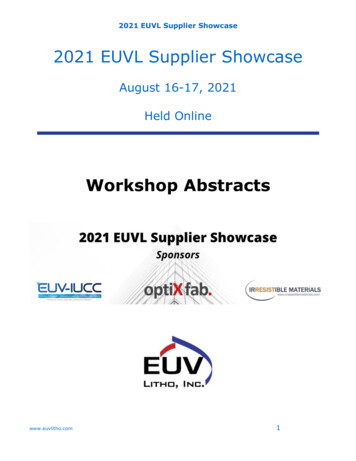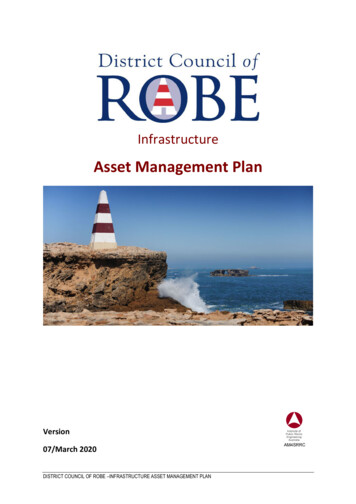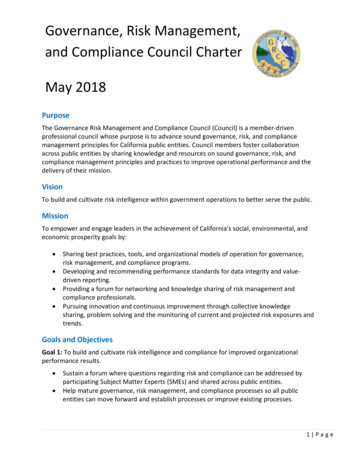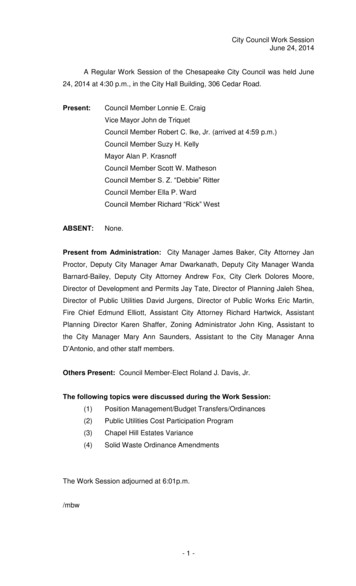
Transcription
The Advisory Council on the Economic Valuebased Solvency FrameworkFinal ReportJune 26, 2020 Financial Services Agency (FSA), 2020. All rights reserved. Brief excerpts may bereproduced or translated provided the source is stated.This is an unofficial translation. Readers should consult the original version of the final reportif they have any doubt.
Table of Contents1. Introduction . 12. Economic value-based solvency assessment . 21) Progress in the economic value-based approach in risk management . 22) International developments related to regulatory and accounting standards . 33. Conceptual building blocks of the economic value-based framework in Japan . 41) Significance and objectives of the economic value-based regulation . 42) Issues to be noted regarding the economic value-based regulation . 73) Towards a prudential policy framework based on the economic value-based approach . 94) Preparing for the new framework . 114. Pillar 1 . 134-1. Standardized model . 131) Adjustment of risk factors/classification to reflect the characteristics of the domestic market152) Adjustments required for solo-based regulation . 163) Other points of discussion regarding the standardized model . 174) Adjustments to achieve certain policy objectives . 204-2. Internal models . 211) Basic concepts . 212) Scope of internal models under Pillar 1 . 224-3. Validation framework for insurance liabilities . 251) Guidance on the calculation and validation of insurance liabilities . 252) Insurance companies' capacity for validation (the actuarial function) . 263) External validation . 284) Supervision by the JFSA . 284-4. Supervisory intervention based on ESR . 281) Supervisory measures under the PCR . 292) Design issues related to the MCR . 305. Pillar 2 . 301) Reorganization of reporting data and the Early Warning System . 322) Insurers’ risk management . 326. Pillar 3 . 331) Disclosure intended for market participants . 342) Disclosure intended for consumers . 357. Making a smooth transition to the new framework . 361) Developing insurers’ capacity and raising awareness among external stakeholders . 362) Dialogue between the JFSA and insurers . 36
Advisory Council on the Economic Value-based SolvencyFrameworkList of MembersChairYONEYAMA TakauProfessor, Faculty of Business Administration, Tokyo KeizaiUniversityMembersKAWAI YoshihiroSHIRASU YokoTAKESHITA SakuraTSUJINO NatsumuHOSHINO TakanoriMATSUYAMA NaokiMIWA TakanobuMORIMOTO YujiObserversITABA KenKAWASAKI TomohisaSHIRAKI HideoSUNAMOTO NaokiProfessor, Graduate School of Management, Kyoto UniversityProfessor, Faculty of Economics, Aoyama Gakuin UniversityPresident, Nagomi FP OfficeSenior Analyst, Mitsubishi UFJ Morgan Stanley Securities Co.,Ltd.Principal, Senior Consultant, Milliman, Inc.Professor, School of Interdisciplinary Mathematical Sciences,Meiji UniversityPartner, Financial Services, KPMG AZSA LLCPresident, Capitas Consulting Co., Ltd.Corporate Officer, Chief Risk Officer, AXA Life Insurance Co.,Ltd.General Manager, Government Relations Dept. and ActuarialDept.Nippon Life Insurance CompanyCorporate Officer, Regional Actuary, AIG Japan Holdings Co.,Ltd.Appointed Actuary, Executive Officer, General Manager,Corporate RiskManagement Department, Fukoku Mutual Life InsuranceMIYAZAKI ToshihiroMIYAMOTO JunCompanyGeneral Manager, Enterprise Risk Management Department,Aioi Nissay Dowa Insurance Co., Ltd.International Standards Committee Vice Chair,The Institute of Actuaries of Japan
AcronymsEEVEuropean Embedded ValueERMEnterprise Risk ManagementESREconomic Solvency RatioEVEmbedded ValueFTField TestIAIGInternationally Active Insurance GroupIAISInternational Association of Insurance SupervisorsICPInsurance Core PrinciplesICSInsurance Capital StandardIFRSInternational Financial Reporting StandardMAVMarket Adjusted ValuationMCEVMarket Consistent Embedded ValueMCRMinimum Capital RequirementMOCEMargin Over Current EstimateORSAOwn Risk and Solvency AssessmentPCRPrescribed Capital RequirementPRAPrudential Regulation AuthoritySFCRSolvency and Financial Condition ReportSMRSolvency Margin RatioUFRUltimate Forward RateVaRValue at Risk
1. IntroductionThe ultimate objective of the policies of the Financial Services Agency of Japan (JFSA) forthe insurance sector is to "protect policyholders by ensuring sound and appropriatemanagement of those who carry out insurance business and fairness of insurancesolicitation, and thereby to contribute to the stability of the lives of the citizens and tothe sound development of the national economy" (Article 1, Insurance Business Act).Based on the Act, various rules and regulations are in place to secure insurers’ financialsoundness, such as rules for standard policy reserves and solvency margin ratio (SMR)regulation.The SMR is defined as an indicator of an insurer's solvency, in excess of the policy reservesthat it holds in order to fulfill the obligations under insurance contracts. It was introducedthrough the revision of the Insurance Business Act in 1996, and has also been used as ameasure for the Early Corrective Action framework (a framework where the JFSA makesprompt supervisory intervention based on the level of SMR and urges insurers to takerecovery actions) since April 1999.However, challenges and limitations related to the SMR were pointed out by the StudyTeam on Solvency Margin Standard,1 which was convened between November 2006 andMarch 2007. Its final report recommended that a study be conducted on the economicvalue-based solvency regulation, after revisions2 to enhance the SMR's reliability thatcan be done in a short-term are made.Following the recommendations of the report, the JFSA has conducted several field tests(FTs) on the economic value-based valuation and supervisory approach since 2010.Through these exercises, the JFSA has assessed insurers’ preparedness, practicalchallenges and quantitative impacts of the economic value-based solvency regime. Inthe meantime, insurers have made progress in integrating the economic value-basedapproach into their risk management framework. There were notable developments onthe international front as well, including the development of the Insurance CapitalStandard (ICS) by the International Association of Insurance Supervisors (IAIS).Japan’s domestic insurance market may become smaller in the future due to its decliningpopulation. In addition, low interest rates are posing another challenge for insurers inJapan. In facing these challenges, some insurance groups are trying to globalize theirbusiness. Customers' needs for insurance are also changing due to various reasons,"On the Calculation Standard of the 0403.pdf) p.191MarginRatio",AvailableinJapaneseThe revision was finalized in April 2010 and was put into force at the end of March 2012. The revisedelements include finer risk measurement, increased confidence level, and tightening of the criteria for capitalresources.21
including the growing burden of healthcare and nursing care, and the advance ofdigitalization. Risks surrounding insurers are also transforming rapidly, due to theprolonged ultra-low interest rate environment, the volatility in the domestic and overseaseconomies and markets, the increasing severity of natural disasters around the world,and the emergence of cyber risk. Given all these factors, the Japanese insurance industryis standing at an important crossroads. Under these circumstances, it is essential forinsurers to further enhance their governance while continuing to meet policyholders'expectations. It is also becoming even more important to build a regulatory andsupervisory framework that is suitable for such an environment.Recognizing such an environment surrounding us, the Advisory Council on the EconomicValue-based Solvency Framework discussed the introduction of the economic valuebased solvency regulation in Japan, as well as the modality of an upgraded supervisoryframework under the new regulatory framework. Although this report refers to thespecifics of the ICS, the focus here is the domestic regulatory and supervisory framework,but not the design of the ICS itself.2. Economic value-based solvency assessment1) Progress in the economic value-based approach in risk managementAt the onset of an insurance contract, insurers guarantee future cash flow (payment ofinsurance benefits) associated with the occurrence of insured events for policyholders,and secure funds for the payment afterwards by earning premiums and investmentincomes. Therefore, ex-post changes in assumptions, such as interest rates and thefrequency of accidents, could cause insurance companies' solvency to deteriorate. 3Indeed, Japanese life insurers faced a crisis triggered by the "negative spread" problemaround the year 2000, which resulted in losses for a number of policyholders and waveredconfidence throughout the insurance industry.The economic-value based approach is effective in risk management for an insurancecompany that takes into account the characteristics of the insurance business and risksthat may arise in the future.4 For instance, it enables insurers to assess their solvencyThe so-called negative spread refers to the state where the investment income (in the fundamental profitin the Japanese accounting practice) is smaller than the original assumption.3In this report, the term "economic value-based approach" is used to refer to the approach to evaluationconsistent with market value or the approach to evaluation of assets and liabilities based on the presentvalue of future cash flow calculated through a method using market-consistent principles, techniques andparameters.42
position in a forward-looking manner by evaluating net assets using current assumptionsand comparing it with the economic value of net assets under various stress scenarios(i.e. changes in assumptions). Moreover, other areas of insurers’ control activities couldalso be enhanced by adopting the economic value-based approach and making themconsistent with their risk control measures: examples are asset and liability management(ALM) that appropriately reflects the durations and cash flow structures of both sides ofthe balance sheet, and product design and profit management activities that take intoaccount the balance between risk and return.5The economic value-based approach is important in enhancing enterprise riskmanagement (ERM), which needs to take into account the balance between risk, returnand capital. Japanese insurers have made efforts to improve their ERM framework. Someof them already utilize and voluntarily disclose economic value-based metrics,6 such asan Economic Solvency Ratio (ESR) based on their internal models and/or embeddedvalues that are consistent with the economic-value based approach.7 The JFSA has alsobeen facilitating the improvement of insurers’ EMR framework, including through therevision of the Comprehensive Guidelines for Supervision of Insurance Companies inFebruary 2014 by expanding references to ERM, taking into account the discussion at theIAIS.2) International developments related to regulatory and accounting standardsThere has been a global trend towards solvency regulation that is based on the economicvalue-based approach. In the European Union (EU), the Solvency II project, which startedin the 2000s, aimed at upgrading the relatively simple Solvency I. The finalized SolvencyII framework has been applied to insurers within the EU area since 2016. There are severalother jurisdictions that have already implemented or are in the process of introducingeconomic value-based solvency regulation.8While the purpose of the economic value-based approach is not necessarily to eliminate the risk of“negative spread,” it enables early detection and measurement of risks and thus controlling them throughthe economic value-based ERM. Unfortunately, the economic value-based approach had not taken holdamong both insurers and the JFSA at the time of Japanese life insurance crisis. This is presumed to have ledto business management problems at many companies at that time.56Page 38 of the material for the first meeting of the Council (available in Japanese)Specifically, the European embedded value (EEV) and the market consistent embedded value (MCEV) areused.7In the United States, economic value is partially reflected in the Risk-Based Capital (RBC) regulation throughthe Principle-Based Reserving (PBR), a new framework for the evaluation of policy reserves. On the otherhand, in the context of ICS, some countries have expressed an intention to investigate methodologiesdifferent from the MAV approach under ICS Version 2.0, separately from the development of the ICS. The83
There has been no international capital standard with respect to solvency regulations forinsurers so far, unlike in the banking sector. The IAIS has been developing the ICS forinternationally active insurance groups (IAIGs) in the 2010s. ICS Version 2.0 for themonitoring period, which was agreed on by the IAIS in November 2019, is scheduled toundergo a five-year monitoring period, and a finalized ICS should be applicable as aprescribed capital standard for IAIGs within the legal framework of each jurisdiction. ICSVersion 2.0 is based on the market adjusted valuation (MAV) approach, which is alignedwith market-consistent valuation.With regard to accounting standards, the International Financial Reporting Standards(IFRS) 17, which is in the process of finalization, has adopted an approach consistent withthe economic value-based approach. For instance, insurance contracts are valued underIFRS 17 based on a risk-adjusted present value of the future cash flows that incorporatesall the available information, and variables that are consistent with observable marketprices.3. Conceptual building blocks of the economic value-based frameworkin Japan1) Significance and objectives of the economic value-based regulationThe current solvency margin ratio (SMR) is premised on accounting balance sheets(based on the Japanese Generally Accepted Accounting Principles, or J-GAAP), thusliabilities are basically valued using locked-in assumptions (i.e. assumptions are fixed atthe time of the inception of an insurance contract). The SMR relies mostly on a relativelysimple factor-based risk measurement, where the required capital is calculated bymultiplying the exposure value by predetermined factors.Therefore, the calculation of SMR is relatively easy and has limited room for insurers toexercise discretion. On the other hand, it may neither sufficiently reflect insurers’medium- to long-term risk structure nor lead to further sophistication or enhancementof their risk management, as was pointed out by a report by the Study Team on SolvencyMargin Standard (April 2007).The area of interest rates is one of the areas where there is a stark contrast betweentreatment under the current SMR and that under the ESR. Under the SMR, the valuationof liabilities is in principle not affected by a fall of interest rates. On the other hand, theIAIS is in the process of developing a framework to assess equivalence between the ICS and the otherapproaches.4
valuation of fixed-income assets improves due to lower interest rates,9 which causes theSMR to rise. In contrast, in the case of ESR, when the duration on the liability side is longerthan on the asset side—as is the case with many Japanese life insurers—the economicvalue of net assets decreases and leads to a decline in ESR, as the rise in the economicvalue of insurance liabilities is larger than that on the asset side. As shown in this example,ESR can be seen as a superior indicator compared with the current SMR, in that it capturesinsurers' medium- to long-term financial soundness in a forward-looking manner, forinstance by identifying risks arising from an interest rate decline in a timely manner.While the SMR has been updated to improve its reliability since it was introduced 24years ago, it cannot be denied that it has certain limitations in addressing theabovementioned challenges. Moreover, we recognize that more and more insurers haveincorporated the economic value-based approach into their risk management framework.Based on these observations, it is necessary for the Japanese insurance sector to moveon to the ESR-based solvency regulation as early as possible, in order to establish aregulatory and competitive environment that enable insurers to meet various needs in asustainable manner, and to ensure policyholder protection from the perspective ofmedium- to long-term financial soundness.10 The primary benefits and objectives of theeconomic value-based regulation in this context can be summarized from the followingthree standpoints:(i) Policyholder protectionThe primary objective of a solvency regulation for insurers is to protect policyholders, byrequiring them to secure a sufficient level of solvency to fulfill insurance obligations evenin face of adverse events.ESR-based regulation will better capture insurers’ medium- to long-term solvencypositions in a forward-looking manner, as insurance companies undertake complex risksranging over long time horizons. By using ESR as a regulatory measure, the JFSA wouldbe able to urge an insurer to re-establish its solvency position at an early stage when itscondition is expected to deteriorate. Such an approach would be more consistent withThe impact of interest rate decline is not recognized in the case of policy reserve-matching bonds andheld-to-maturity securities.9The Insurance Core Principles, developed by the IAIS, stipulates that the "supervisor establishes capitaladequacy requirements for solvency purposes so that insurers can absorb significant unforeseen losses andto provide for degrees of supervisory intervention" (ICP17) and that the "supervisor requires that a totalbalance sheet approach is used in the assessment of solvency to recognize the interdependence betweenassets, liabilities, regulatory capital requirements and capital resources and to require that risks areappropriately recognized" (ICP17.1). In a total balance sheet approach, all the risks affecting any componentsof the balance sheet are assessed in an integrated manner, and interactions between assets, liabilities,required and available capital are recognized.105
the fundamental objective of the JFSA’s policy for the insurance sector, which is to protectpolicyholders over the entire contract periods.(ii) Enhancing risk management (ERM) of insurersIn order to meet consumers’ needs in a sustainable manner, it is essential for insurers notonly to meet regulatory requirements but also to enhance their risk managementproactively. Some members of the Council were of the opinion that misalignedsensitivities between ESR (a measure used in risk management) and the current SMR(regulatory standard) could become an impediment to better risk management, wheninsurers are required to control both. Another opinion expressed in the Council was thatinsurers need to recognize interest rate risks appropriately and transform their overallrisk profile, so that they could continue to perform their primary role of undertakinginsurance risks.In light of the abovementioned points, the introduction of ESR as a regulatory benchmarkwill be an important step to enhance insurers’ risk management. For insurers that arealready utilizing ESR based on their internal models, it will bring better alignment of theirrisk management practices with the regulatory framework, thereby removing theabovementioned possible impediment. For other companies that have not adopted ESR,the introduction of ESR as a regulatory requirement will facilitate the development of aneconomic value-based risk management framework in these insurers.(iii) Provision of information to consumers and market participantsInsurers publish information on their business and financial positions that are requiredunder the existing disclosure requirements, while disclosing additional information on avoluntary basis. Some insurers voluntarily disclose their ESRs that are calculated basedon their internal models as well as EV, as economic value-based information is useful formarket participants as an indicator of companies' financial soundness and enterprisevalue, which may not be adequately reflected in accounting-based disclosure. On theother hand, some members of the Council pointed out that the usefulness of suchvoluntarily disclosure might be somewhat limited, due to the lack of comparabilitybecause of the differences in the definitions and methodologies adopted among insurers.Information disclosure concerning financial soundness will be enhanced and becomemore comparable, if insurers start to disclose information based on a universal (economicvalue-based) standard used as a regulatory benchmark. It will facilitate dialogue betweeninsurers and external stakeholders, 11 which will improve corporate governance andIn this report, the term "external stakeholders" refers to any parties related (or potentially related) toinsurers other than the supervisory authority, such as market participants (e.g. investors) and consumers(current and potential insurance policyholders).116
discipline of insurers through external scrutiny.2) Issues to be noted regarding the economic value-based regulationWhile ESR has many advantages, introducing ESR as a regulatory measure may notautomatically bring the benefits mentioned in 1) of Section 3. Some members of theCouncil called for the need to consider the following points when designing ESR as aregulatory requirement.(i) Impact on insurers’ behaviorCompared with the current SMR, ESR could fluctuate significantly in response to changesin the economic environment, depending on the balance sheet structure, while itrepresents a merit of the economic value-based approach in that it reflects the fact thatinsurers have exposures to market risks that give rise to such volatility.There was an opinion that insurers may view the regulatory minimum (ESR 100%) as alevel that cannot be breached even temporarily when an insurer faces a rapid andsignificant shock to interest rates or equity prices, 12 which may restrict insurer’smanagerial decisions in a manner that could bring about negative side effects.13As a response to such a view, it was pointed out that the volatility of the regulatory ESRcould be mitigated to an extent by adopting the Ultimate Forward Rate (UFR) for discountrates. There could be a realistic path to mitigate potential side effects by increasing theconsistency between the regulatory framework and insurers’ risk management (asdiscussed in 2) of Section 5), thereby making the regulatory environment and supervisoryactions more predictable for insurers. Such a viewpoint would also be important indesigning ESR as a regulatory framework and the operations of supervisory interventionsbased on ESR.(ii) Impact on the provision of products that suit consumers' needsThe Council discussed potential impacts of ESR-based regulation on the provision ofIn relation to this, there was an opinion that we need to make sure that the meaning and the nature ofeconomic value-based indicators are correctly understood to avoid misinterpretation and reputational risks,as the management of an insurer has to pay attention to reputation from outside, regardless of whether andhow supervisory measures are taken.12Several possibilities were pointed out in this context: that the fall in investment income due to restrictionon investment options may affect insurers’ ability to fulfill insurance obligations or pay dividends; that firesale of assets may be a cause in times of stress; and that insurers may be forced to excessively curb sales oflong-term guarantee products.137
insurance products, referring to the cases in Europe (Germany in particular).The characteristics of products provided by insurance companies significantly varyamong jurisdictions. In Germany, saving-type pension products, particularly traditionalfixed-rate ones, have had a large share in the life insurance market. However, since the2010s, an uptrend has been observed in the share of so-called hybrid type pensionproducts, which link the amount of pension benefits to investment performance, whilethese products typically have a certain floor as minimum.14 While it is difficult to identifythe exact causes of such a trend, this may be regarded as a case where insurers have triedto strike a balance between adapting to changes in the economic (low interest rates) andregulatory (the introduction of Solvency II) environment and meeting consumers' needs.In general, it may be inevitable for insurers to shift their product lines in accordance withthe changes in the economic environment and consumers' needs. When regulatoryreforms take place, the new framework should not distort insurers’ product strategies ina manner that inappropriately affects insurers and consumers. In this respect, somemembers of the Council suggested that the government should consider measures tolower the hurdles for insurers to provide long-term guarantee products,15 given that theeconomic environment is beginning to make it challenging for them to provide suchproducts.(iii) Impact on proactive enhancement of insurers’ risk managementThere are various methodologies that could be adopted in economic value-basedsolvency assessment, e.g. the choice of the discount rates and techniques for riskmeasurement. In the context of insurers’ own risk management, it is important for themto choose the most appropriate from a range of available methodologies in accordancewith their own risk profile, business structure, and the purpose and use. On the otherhand, it might be difficult to account for idiosyncrasies across insurers when designing astandardized model for solvency regulation (a basic calculation model of ESR that isavailable to all insurers).In the case of ICS Version 2.0, for example, some of the assumptions are set in a uniformmanner, as in the case of the Ultimate Forward Rate (UFR) not based on observed marketIt appears that it is not leading to a rapid increase in complaints from consumers, at least based onpublicly disclosed information. On the other hand, an insurer may choose run-off if they failed to adjust tochanges in the economic and regulatory environment. While it could be a rational choice from an economicstandpoint, it was pointed out in the Council that some of the run-off companies have given rise to concernsover the protection of consumers and reputational issues.14Issuance of ultra-long-term bonds, as well as a flexible product approval process by the regulator toencourage development of insurance products that provide a range of options available to consumers whilelimiting interest risk for insurers, were cited as an example.158
rates, as discussed l
ICP Insurance Core Principles . prompt supervisory intervention based on the level of SMR and urges insurers to take recovery actions) since April 1999. However, challenges and limitations related to the SMR were pointed out by the Study . including the growing burden of healthcare and nursing care, and the advance of digitalization. Risks .











